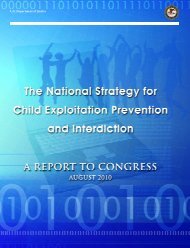Chapter 12 - Wait List - Florida Department of Children and Families
Chapter 12 - Wait List - Florida Department of Children and Families
Chapter 12 - Wait List - Florida Department of Children and Families
- No tags were found...
You also want an ePaper? Increase the reach of your titles
YUMPU automatically turns print PDFs into web optimized ePapers that Google loves.
DCF Pamphlet 155-2: <strong>Wait</strong>ing <strong>List</strong>1. If a client has to wait longer than four (4) days for a residential bed for either mentalhealth or substance abuse, they go on the waiting list.2. If a client has to wait longer than four (4) days for a bed in Detox, they go on thewaiting list.3. If a client has to wait longer than 14 days for outpatient services (both mental health<strong>and</strong> substance abuse), intervention (substance abuse only), or methadone services,they go on the waiting list.4. If a client has to wait longer than 14 days for a non-mental health funded service,they go on the waiting list.5. A client referred to a state treatment facility goes on the waiting list when the packetis considered complete.D. If the client is placed on the <strong>Wait</strong>ing <strong>List</strong> for a substance abuse service, there should bea supporting ASAM to indicate the service is needed.III. Maintaining the Substance Abuse <strong>Wait</strong>ing <strong>List</strong>A. Count those individuals who have been screened <strong>and</strong> are in need <strong>of</strong> substance abusetreatment from your agency. This must be a face-to-face screening (not a telephonecontact).B. In order for the individual to remain on the waiting list, a face-to-face meeting, telephonecontact or other documented contact must have taken place at least within 30 days <strong>of</strong>the initial contact <strong>and</strong> at least every 30 days thereafter. The contacts should be morefrequent than every 30 days; however, the individual must be contacted within the 30-day time period.C. Individuals in treatment, but waiting for the appropriate level <strong>of</strong> service, should becounted as waiting for the appropriate level <strong>of</strong> service. For example, a person receivingone hour <strong>of</strong> outpatient treatment once a week while waiting to enter a residentialprogram should be counted as waiting for residential treatment.D. Each individual counted on the waiting list must have supporting documentation, i.e., the<strong>Wait</strong>ing <strong>List</strong> Documentation Form maintained in a file separate from the client’s clinicalrecord. The information on this form will be used to verify what is reported on the waitinglist.E. <strong>Wait</strong>ing list information must be updated on a monthly basis. Any individual who has nothad a face-to-face, telephone or other documented contact in the last 30 days should beremoved from the waiting list.F. Incarcerated clients are not counted as waiting for treatment. The exception is when anincarcerated individual’s only condition for being released is admission into a substanceabuse treatment program. In this case, the incarcerated person will be counted aswaiting for treatment.IV. Maintaining the Substance Abuse Monthly 90% Capacity ReportA. The provider will complete the attached form <strong>and</strong> notify the Circuit/Region SubstanceAbuse <strong>and</strong> Mental Health (SAMH) Program Office by the 30 th <strong>of</strong> each month regardingprograms that have reached 90% capacity. The notification may be submitted via Email.B. The Circuit/Region SAMH Program Office will maintain monthly 90% capacityinformation for providers in their circuit/region <strong>and</strong> will make the information availableupon request by the Substance Abuse Program Office.Version 10.3 <strong>12</strong>-3 Effective October 1, 2013

















